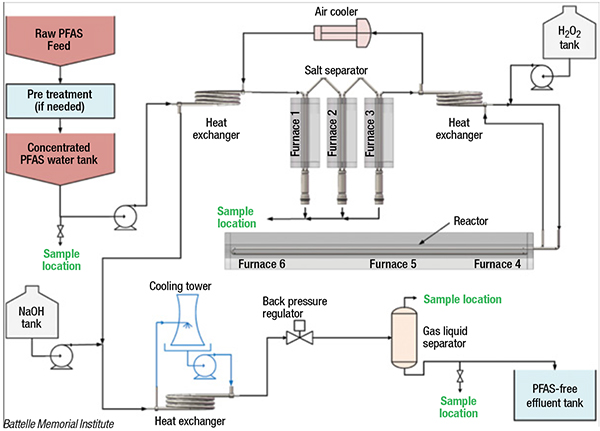The presence of per- and polyfluoroalkyl substances (PFAS) in wastewater and groundwater has garnered increased attention as a health and environmental issue because of their recalcitrance and bioaccumulation. To complement existing PFAS separation technologies, the Battelle Memorial Institute (Columbus, Ohio; www.battelle.org) has developed a technology, known as the PFAS Annihilator, for destroying both short- and long-chain PFAS compounds using supercritical water oxidation (SCWO). This month, the first on-site deployment of the technology has begun at a wastewater treatment plant.
Above its critical point (>374°C and >221 bars), water has both liquid and gas properties. The Battelle process uses water around these temperatures and pressures to mineralize a wide range of PFAS species. This new SCWO technology is related to similar processes used previously to destroy polychlorinated biphenyls (PCBs), but now has been optimized to destroy PFAS molecules.
In the process (diagram), an oxidant is introduced into the supercritical water reactor, and a base (NaOH) is added to neutralize the hydrofluoric acid formed by the reactions. The PFAS Annihilator has demonstrated the ability to destroy 99.99% of total PFAS in various aqueous feeds, Battelle says, leaving inorganic salts, such as NaF and Na2SO4, as inert end-products.

“Battelle’s SCWO PFAS-destruction technology can be used alone or in combination with another process that can concentrate the PFAS before it is destroyed,” explains Dan Longbrake, director of commercial business at Battelle. “To date, our focus for PFAS Annihilator has been on aqueous wastes, such as PFAS-containing wastewater or landfill leachate, but Battelle is also developing SCWO for destruction of PFAS in solid materials, such as contaminated soil,” notes Longbrake. The technology will also be deployed to reduce or eliminate stockpiles of firefighting foams, which contain high levels of PFAS.
The PFAS Annihilator is available as a mobile unit that can be transported on a trailer for episodic and demonstration uses. Battelle is also constructing a larger mobile unit.